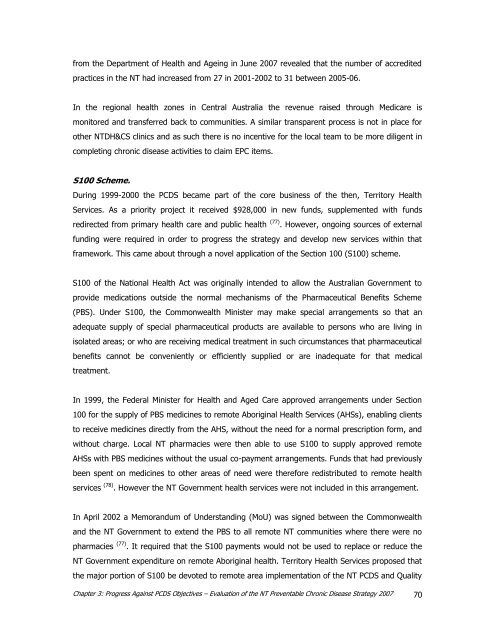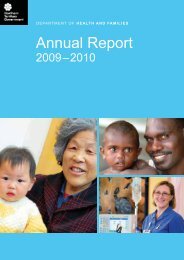PCD Strategy Evaluation 2007.pdf - NT Health Digital Library ...
PCD Strategy Evaluation 2007.pdf - NT Health Digital Library ...
PCD Strategy Evaluation 2007.pdf - NT Health Digital Library ...
Create successful ePaper yourself
Turn your PDF publications into a flip-book with our unique Google optimized e-Paper software.
from the Department of <strong>Health</strong> and Ageing in June 2007 revealed that the number of accreditedpractices in the <strong>NT</strong> had increased from 27 in 2001-2002 to 31 between 2005-06.In the regional health zones in Central Australia the revenue raised through Medicare ismonitored and transferred back to communities. A similar transparent process is not in place forother <strong>NT</strong>DH&CS clinics and as such there is no incentive for the local team to be more diligent incompleting chronic disease activities to claim EPC items.S100 Scheme.During 1999-2000 the <strong>PCD</strong>S became part of the core business of the then, Territory <strong>Health</strong>Services. As a priority project it received $928,000 in new funds, supplemented with fundsredirected from primary health care and public health (77) . However, ongoing sources of externalfunding were required in order to progress the strategy and develop new services within thatframework. This came about through a novel application of the Section 100 (S100) scheme.S100 of the National <strong>Health</strong> Act was originally intended to allow the Australian Government toprovide medications outside the normal mechanisms of the Pharmaceutical Benefits Scheme(PBS). Under S100, the Commonwealth Minister may make special arrangements so that anadequate supply of special pharmaceutical products are available to persons who are living inisolated areas; or who are receiving medical treatment in such circumstances that pharmaceuticalbenefits cannot be conveniently or efficiently supplied or are inadequate for that medicaltreatment.In 1999, the Federal Minister for <strong>Health</strong> and Aged Care approved arrangements under Section100 for the supply of PBS medicines to remote Aboriginal <strong>Health</strong> Services (AHSs), enabling clientsto receive medicines directly from the AHS, without the need for a normal prescription form, andwithout charge. Local <strong>NT</strong> pharmacies were then able to use S100 to supply approved remoteAHSs with PBS medicines without the usual co-payment arrangements. Funds that had previouslybeen spent on medicines to other areas of need were therefore redistributed to remote healthservices (78) . However the <strong>NT</strong> Government health services were not included in this arrangement.In April 2002 a Memorandum of Understanding (MoU) was signed between the Commonwealthand the <strong>NT</strong> Government to extend the PBS to all remote <strong>NT</strong> communities where there were nopharmacies (77) . It required that the S100 payments would not be used to replace or reduce the<strong>NT</strong> Government expenditure on remote Aboriginal health. Territory <strong>Health</strong> Services proposed thatthe major portion of S100 be devoted to remote area implementation of the <strong>NT</strong> <strong>PCD</strong>S and QualityChapter 3: Progress Against <strong>PCD</strong>S Objectives – <strong>Evaluation</strong> of the <strong>NT</strong> Preventable Chronic Disease <strong>Strategy</strong> 2007 70
















